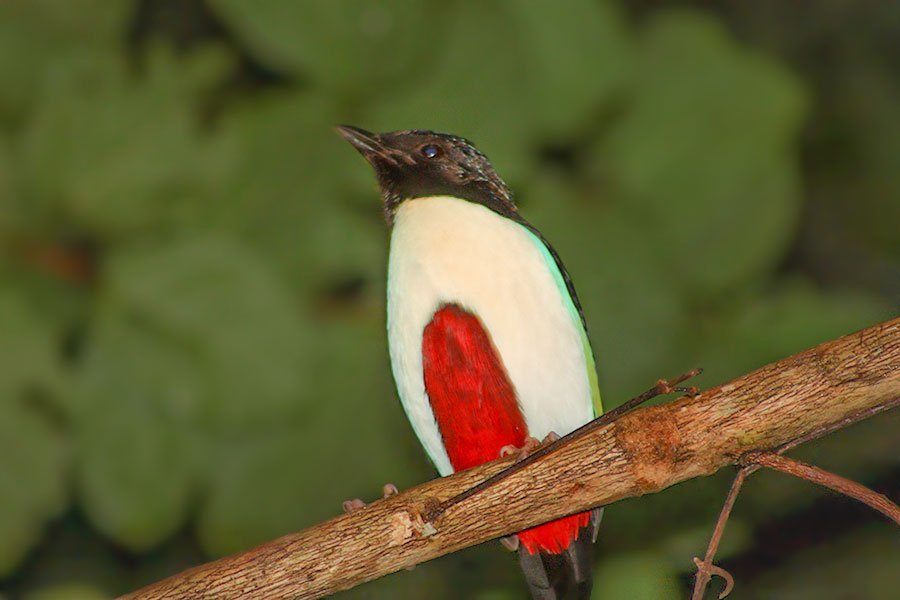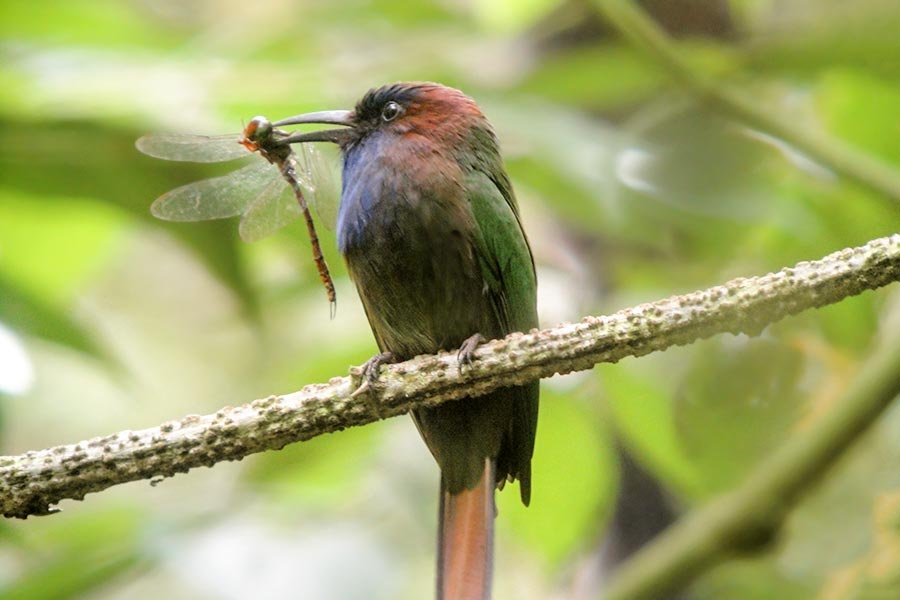Sulawesi Halmahera Birding 21 Days 20 Nights
Makassar – Lompobattang – Karaenta – Lore Lindu – Manado – Dumoga Bone n.p - Tangkoko n.p. – Halmahera (Foli & Tobelo) – Minahasa (Mt.Mahawu). BookingDay 1: Arrival into Makassar for overnight stay
Day 1. On your arrival at International airport Makassar (formally known as Ujung Pandang), you will be picked up then we travel into Lompobattang for an overnight stay in Malino.
Day 2. This morning we will walk shortly into the Lompobattang Mountains where we will find our two main targets the Lompobattang Flycatcher and Black-ringed White-eye. Both are endemics to Sulawesi which is known only from the southern arm of Sulawesi. Lompobattang Flycatcher is known only from these mountains. In this birding area we will also find Lompobattang Leaf Warbler split from Sulawesi Leaf Warbler, Ashy and Sulawesi Pygmy Woodpeckers, Sulphur-vented Whistler, and many more. On the way back to Makassar hopefully we may encounter a localised Pale-bellied Myna along the way.
Day 3. In the morning we will go birding to the limestone karst forest at Karaenta. This forest is also home to several other Sulawesi endemics including White-necked Myna, Piping Crow, Sulawesi Dwarf Hornbill, Sulawesi Malkoha, and Sulawesi Brown Flycatcher. From here we may also visit the nearby fishponds where Javan Plover is often to be found then take a short flight to Palu in central Sulawesi. Arrive Palu we will stop birding at a rice pady fields for White-headed Munia then continue driving to one of Indonesia’s greatest national parks – Lore Lindu. We will stay for a four nights in Wuasa village.
Days 4-6. Lore Lindu National Park is lowland forest from 200m asl to 2610m asl rich of Sulawesi’s endemics where a best birding site to see specialties birds. The best birding site is from about 1000 to 1500m asl and some spealties are found above 1500m asl. Anaso track an old logging road and surounding area will be a high recommended site to birdwatch where we will see the four of the most wanted endemics; Sulawesi Robin, Satanic Nightjar, Geomalia, and one of the world’s most spectacular bee-eaters; Purple-bearded Bee-eater which is often apear in roadside banks and giving great views. Some other Sulawesi’s endemics are also possible to be found such Grey-headed Imperial Pigeons, Superb and Red-eared Fruit Doves while the inconspicuous Sombre Pigeon is sometimes encountered. We may also see more endemics in feeding flocks are such Maroon-backed Whistler, Sulphur-bellied Whistler, Sulawesi Heleia, Malia, Sulawesi Thrush which behaves more like a babbler than a thrush, Sulawesi Pygmy Woodpecker, Sulawesi Spangled Drongo, Cerulean Cuckooshrike, Mountain Cicadabird, Sulawesi Fantail, Sulawesi Myzomela, Crimson-crowned Flowerpecker, both Lesser and Greater Myzas, Hoevell’s Warbling-flycatcher, and the inconspicuous Hylocitrea which is now studied firmly in its own monotypic family rather than Whistler.
Day 7. Birding again in the morning in search of any missing species at Lore Lindu then we return to Palu in the afternoon. We will stop birding at a savana and grassland in search of Red-backed Buttonquail, Savanna Nightjar and some Munias which we might miss in Lore Lindu such Pale-headed Munia and Black-faced Munia. Night in Palu.
Day 8. We will fly to Manado then long drive to Kotamobagu through Minahasa peninsula of north Sulawesi. We will base at a best hotel in Kotamobagu for four nights where from here we explore to some birding sites.
Days 9-11. On these days, we will explore to some birding sites of the nearby Dumoga Bone National Park and the lowland forest areas including Tapakolintang and Tambun. We will look for some Sulawesi endemics which more easy here rather than in Lore Lindu such Sulawesi Roller, Bay Coucal, Black-billed Koel and Sulawesi Malkoha in forest tangles, Sulawesi Triller, Pied Cuckooshrike, White-faced Cuckoo Dove, Yellow-breasted Racquet-tail, Oberholser’s Fruit Dove, and both Sulawesi and Pygmy Hanging-parrots. We may also see here Green-backed Kingfisher and in fortune Sulawesi Dwarf Kingfisher and Sulawesi Lilac Kingfisher. Some raptors of the Sulawesi endemics are also possible here; Vinous-breasted Sparrowhawk, Spot-tailed Sparrowhawk and Sulawesi Goshawk, Sulawesi Serpent Eagle, Sulawesi Hawk Eagle and Sulawesi Honey Buzzard are all regular, while Spotted Harriers also occur around this area. At night we have good chances for Sulawesi Scops Owl, Sulawesi Masked Owl and both Speckled and Ochre-bellied Boobooks. Not far from this area is also possible for White-necked Myna and Sulawesi Myna including Sulawesi Roller.
We will also visit the nesting grounds of Maleo, the unique bird and a large pied megapode which is one of the topest bird to see in Sulawesi as the bird is Sulawesi’s most famed and enigmatic species. Maleos dig some holes to lay down the eggs and use geothermal heat in the volcanic soil in their communal breeding grounds to incubate their eggs or use sunshine heat in the beach soil or river soil if there is not volcanic surrounding to their nesting grounds. The periode of the time to incubate normally about 60 days. The temparature of the soils is about 32-34 degrees celcius. The chicks are able to fly as soon as they dig their way out of the ground after hatching! It needs 1 to 6 hours to way out of the ground. It depends on the soil, easy or difficult, soft or hard. Maleos normally use the same holes to lay down the eggs of the year.
We will also visit to another birding area, Gunung Ambang which is in submontane forests that are equally rich in bird life. The area is good for some Sulawesi’s endemics and local endemics include Cinnabar Boobook though this bird is also occur in Lore Lindu. Another local speciality is Matinan Flycatcher, known only from the hill forests of the Minahasa Peninsula at this moment. We still have oportunity to see Scaly Kingfisher in this forest area if we missed it in Lore Lindu National Park.
Day 12. This morning is happy our birding seeking out anything we have missed then we return to Manado in the afternoon for an overnight stay.
Day 13. Arriving Halmahera and drive to Foli. On the way to Foli, we will stop at a beach for Beach Kingfisher, and some more. Birding in the afternoon. We will stay for four nitghs at a good accommodation at Foli.
Days 14-16. Our birding at Foli should give us opportunity to see the most prized species on the planet Wallace’s Standardwing at the lek site and Ivory-breasted Pitta. Wallace’s Standarwing in its lek site is an extraordinary bird of paradise a truly magical experience as the males call loudly greeting the rising sun by jumping up and parachuting down again, sticking out their brilliant white standards in the hope a female approaches. We also expect to see Azzure Dollar bird at a roost as I have seen it several times at the same area by the sunset.
We will have happy our birding where there is a good place to encounter parrots are flying arround and perch in a fruting tree such Moluccan King Parrots, Chattering Lory, Violet-necked Lory, White Cockatoos. Unfortunatley these parrots are declining due to trapping of these beautiful species for the cage-bird trade. Other endemics that we will encounter are such Halmahera Oriole (Dusky Brown Oriole), Halmahera Paradise Crow, Halmahera Flowerpecker, Rufous-bellied Triller, White-streaked Friarbird, Goliath Coucal. We may also see such the elusive Scarlet-breasted Fruit Dove, striking Grey-headed and cute Blue-capped Fruit Doves, Moluccan and Cinnamon-bellied Imperial Pigeons. Gurney’s Eagle is more common here and normally come to its roosting tree. We might also see Halmahera Swiftlet, Moustached Treeswift, Blue-and-White, Sombre and Beach Kingfishers, Common Paradise-Kingfisher, Rainbow Bee-eater, Blyth’s Hornbill, Moluccan Cuckoo-shrike, Golden Bulbul, Slaty and Moluccan Monarchs, etc.
We cannot miss birding at night as we hope to spot-light Moluccan Owlet Nightjar and Moluccan Scops Owl. Halmahera Boobook is harder bird to see comparing with the two others but still have opportunity.
Day 17. We travel to the north-west of Halmahera where we will overnight stay. We will continue driving further along the coast to visit the communal breeding grounds of the Moluccan Scrubfowl. This bird is globally-threatened as locals always collect their eggs and with some luck we might hope to encounter one or more of these rare birds as the birds come down from the forests at night to lay their single egg on the beach sands. Night in Tobelo.
Day 18. Uppon arrival in Sam Ratulangi Airport Manado on Sulawesi we will drive to the nearby Tangkoko-Dua Saudara National Park and will make some stops birding at view points and may encounter some Sulawesi’s endemics such as Grossbeak Myna, White-necked Myna, White-rumped Cuckooshrike, Yellow-breasted Racquet-tail, Ornate Lorikeet, both Sulawesi and Pygmy Hanging-parrots, and Knobb Hornbill. Nights at Tangkoko.
Days 19-20. Tangkoko is wonderful park with a special place for Sulawesi’s endemic Kingfisgers and best birding site for some endemics. This birding site is from coastal to submontane forest, supports a large number of Sulawesi’s endemic birds such Lilac-cheeked, Green-backed and Sulawesi Dwarf Kingfishers though we might possible see them in Dumoga Bone National Park. We will also take a palmboat trip into the mangroves to search for a fourth endemic kingfisher, Black-billed/Great-billed Kingfisher.
Other endemic species we might see in this park are such Red-backed Thrush, Sulawesi Pygmy and Ashy Woodpeckers, both Sulawesi and Knobb Hornbills (hopefully if apair of Knobbed Hornbill has a baby inside the nest in a hole of a big tree, we have opportunity to see and take photographs of a male of Knobbed Hornbill brings food to the nest to feed the baby every morning and evey afternoon). Tangkoko is also a good place to see such as the gorgeous Red-bellied Pitta and sometimes Hooded Pitta including Tabon Scrubfowl and Stephan’s Dove. In more open country we still have opportunity again to see Both Sulawesi and Pygmy Hanging Parrots, Sulawesi Roller, Silver-tipped Imperial Pigeon, White-faced Cuckoo Dove, Sulawesi Malkoha, and some more. We still have good opportunity to see the smallest primates in the world; the Spectral Tarsier in their roost tree and will have opportunity to take photographs. Before sunset they will come out from their roost tree and jump out from tree to tree at low level of the tree then later will disappear to look for their food. We might also see troops of Sulawesi Crested Macaque, which patrol the forest like miniature Gorillas.
Day 21. In the last morning of the tour we will have happy hour birding in the open country from view point for some missed bird we need before transfer you to the airport or we will leave early this morning to visit the small forest patches of Gunung Mahawu in the Minahassa highlands above Manado. Though the forest is small but it is good forest to birdwatch where we still have opportunity to locate Scaly Kingfisher, the most elusive of the endemic Sulawesi kingfishers. There are many birds here we might also possible to find like at Lore Lindu. From here we return to Manado Airport to connect with your international flight.






